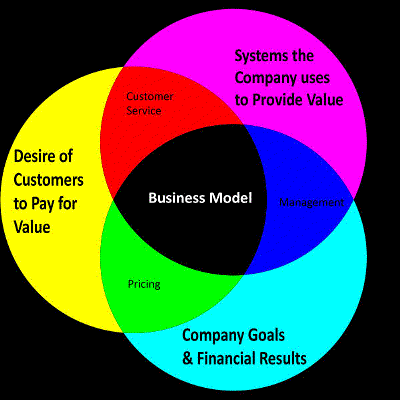You wouldn’t ever spend a penny of your company’s money without expecting some benefit. You spend advertising to get sales, you spend on inventory to have something to sell. You spend on sales people because they put money in your pocket.
A business model is a tool to help you figure out when to spend how much, what results you should be getting when, and to know in advance when you’ll have to raise more money from investors.
How, you ask, can you predict all those things with enough accuracy to bother? Well, you can’t. Certainly not at first. But the fact that you can’t predict the future doesn’t mean you shouldn’t develop a tool that helps you understand it – especially as the future becomes the present. That tool is the business model. Probably the most important thing you’ll do as CEO is develop, refine and then USE the business model when decisions are being made in the company.

What is a Business Model? It’s an understanding of how these three things intersect:
1. What the customers want to buy (and why).
2. How the company will make and sell those things.
3. How the company will make money from doing so.
As you can imagine, there is a bit of guesswork involved. We call them assumptions. And it’s important to write them down and test them against reality, then revise them as you learn more. Pretty soon they’ll actually be dependable.
The other thing you’ll need assumptions about (at least at first) is the capacity of parts of your business. Production capacity is pretty easy to come by – how many widgets can a machine make in a day. But Sales capacity (how much can you sell before you need to hire an additional sales person) and administrative support are things you’ll have to guess and refine.
The parts of your model that you can get exactly are your costs.
Many people don’t build a model because so much of it involves guesses (I mean assumptions) so they don’t think it’s valuable. They are wrong.
I build mine based on cash flow. On the dollars page I put all the sources of cash in on top of the reasons to spend cash out. I group the cash in by product line and the cash out by reasons to spend: COGS, Cost of Sales & Marketing, Overhead, Paying back lenders & investors and PROFIT. Profit can be money taken out of the company or money kept in and used for growth.
On the assumptions page, I make all kinds of assumptions about how long it will take for customers to buy, what the average sale size will be, how interest rates will affect my business, how long it will take to raise more money etc. Make sure the numbers on the dollars page accurately reflect these.
I make a third page for capacity. This is a specialized form of assumptions that relates how much it costs to accomplish or produce a certain number of results. Things like how many people can each administrative assistant support, to how big can you grow before you have to rent larger facilities.
When you first start this, the number of details can seem overwhelming. Don’t worry. Start at the highest level and add details as you need them.
Takeaways:
- A complete business model will help you make every business decisions.
- It will help you adapt quickly when things don’t go as planned (and they won’t).
- It’s not a trivial task to build and use a business model. But I know of no better way to grow a company that has a functioning CEO. Without it, you’ll always be just the CCB – chief cook and bottle washer.
Technorati Tags: Business Model, Small Business, Entrepreneur, Management, How to be CEO, CEO Skills